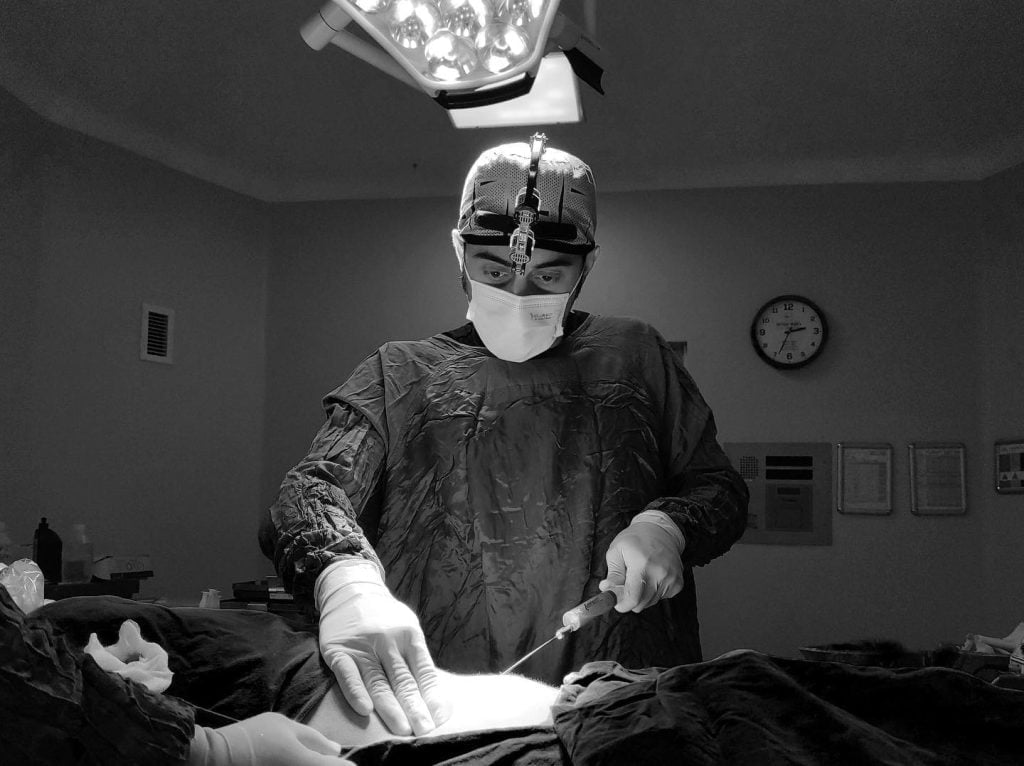Table of Contents
I. Introduction: Reshaping Facial Identity
Imagine a sculptor meticulously molding clay, expertly shaping it to reflect a desired image. This is the essence of facial feminization surgery (FFS) and facial masculinization surgery (FMS) – transformative procedures that sculpt the face to align with one’s true gender identity. But the transformation extends beyond simply adjusting prominent features like the nose or chin. Indeed, a crucial yet often overlooked aspect lies in the delicate artistry of hairline alteration. Just like a perfectly framed portrait, the hairline provides balance and harmony to the face, playing a pivotal role in achieving authentic and aesthetically pleasing results.
II. Crafting a Feminine Contour: Hairline Alteration in FFS
2.1 The Essence of a Feminine Hairline: Softness and Harmony
When we envision a feminine hairline, what comes to mind? Typically, it’s a gently rounded shape, often with a slightly lower position on the forehead. This creates an impression of softness and youthfulness, key elements in achieving a traditionally feminine aesthetic. However, achieving this desired look requires a keen understanding of the underlying bone structure and meticulous manipulation of both soft tissues and hair follicles.
2.2 Techniques for Lowering the Hairline: Sculpting a New Horizon
Imagine pulling a curtain to reveal a breathtaking view. That’s the basic principle behind scalp advancement surgery. During this procedure, surgeons make an incision along the hairline, carefully lift the scalp forward, and then meticulously secure it in its new, lower position. This effectively lowers the entire hairline, creating a more youthful and feminine appearance. However, it’s important to note that scalp advancement may not be suitable for everyone. Individuals with very tight scalps or those seeking a significant lowering of the hairline might explore alternative options.
Sometimes, achieving a truly harmonious feminine hairline requires more than simply repositioning the scalp. In cases where the forehead is excessively prominent or the brow bone protrudes, forehead reconstruction comes into play. This procedure involves reshaping the underlying bone structure to create a smoother, more rounded contour. Imagine smoothing out the rough edges of a sculpture – that’s essentially what forehead reconstruction accomplishes. The result? A more balanced and feminine profile.
2.3 Mastering Temporal Recession: Framing the Face
The temples, those delicate areas at the sides of the forehead, also play a crucial role in framing the face. In women, temporal recession, or a receding hairline at the temples, can create an undesirable masculine appearance. Fortunately, there are effective techniques to address this concern.
Hair transplantation isn’t just for restoring hair on the scalp. It can also be used artistically to reshape the hairline, including filling in temporal recession. This meticulous procedure involves harvesting individual hair follicles from a donor area, typically the back of the head, and transplanting them to the temples. The result is a fuller, more youthful hairline that complements the overall facial structure.
In some cases, addressing temporal recession requires a gentler approach. Soft tissue manipulation involves repositioning or reshaping the soft tissues in the temple area. This subtle yet effective technique can create a softer, more feminine contour without the need for hair transplantation.

III. Defining Masculine Features: Hairline Alteration in FMS
3.1 The Hallmark of a Masculine Hairline: Strength and Structure
While a feminine hairline often emphasizes softness and roundness, a masculine hairline exudes strength and structure. Think of a squared-off shape, sometimes with a slightly receded appearance at the temples. This creates a look of maturity and authority, embodying the classic characteristics often associated with masculinity. Achieving this transformation requires a keen eye for detail and a deep understanding of the nuances that distinguish masculine facial features.
3.2 Creating Hairline Recession: Receding with Purpose
Contrary to popular belief, a receding hairline isn’t always a sign of aging. In fact, for individuals seeking to masculinize their appearance, a carefully crafted recession can actually enhance their desired aesthetic. But achieving a natural-looking recession requires a strategic approach.
Yes, you read that right! Hair transplantation isn’t just for restoring lost hair; it’s a versatile tool that can also be used to create a more masculine hairline. In this context, surgeons strategically transplant hair follicles to create a subtle recession at the temples, mimicking the natural patterns of male pattern baldness. This creates a more defined and angular hairline, enhancing the overall masculine appearance.
In cases where a more pronounced recession is desired, scalp reduction surgery offers a more dramatic solution. This procedure involves removing a small section of scalp from the front of the head, effectively pulling the hairline back and creating a more receded appearance. While highly effective, scalp reduction surgery is a more invasive procedure than hair transplantation and requires careful consideration.
3.3 Emphasizing Temporal Advancement: Highlighting Masculinity
Remember the temples, those subtle yet crucial areas flanking the forehead? Just as they can be modified to soften the face in FFS, they can also be enhanced to accentuate masculinity.
In some cases, achieving a more masculine temple contour requires a gentle touch. Soft tissue manipulation, similar to techniques used in FFS, involves repositioning or reshaping the soft tissues in the temple area. However, the goal here is not to soften but to define, creating a more angular and chiseled appearance.
For individuals seeking a more dramatic transformation, bone contouring offers a permanent solution. This intricate procedure involves reshaping the underlying bone structure of the temples, creating a more pronounced and defined masculine contour. Bone contouring is typically reserved for cases where soft tissue manipulation alone cannot achieve the desired results.
IV. FFS vs. FMS Hairline Approaches: A Tale of Two Transformations
While both FFS and FMS utilize similar techniques for hairline alteration, the goals and desired outcomes differ significantly. Think of it like this: both sculptors might use the same tools, but one aims to create a delicate flower, while the other envisions a powerful lion.
4.1 Choosing the Right Path: Factors Influencing Technique Selection
Deciding on the most appropriate hairline alteration technique depends on a multitude of factors. For both FFS and FMS, these include:
- Existing Hairline: The starting point plays a crucial role. A patient with a high hairline might benefit from scalp advancement, while someone with significant temporal recession might consider hair transplantation.
- Desired Outcome: How drastic of a change is desired? Subtle adjustments might call for soft tissue manipulation, while a dramatic transformation might necessitate bone contouring.
- Overall Facial Structure: The hairline should harmonize with other facial features. A skilled surgeon will consider the balance between the forehead, brow bone, nose, and chin when recommending a specific technique.
- Individual Preferences: Ultimately, the patient’s vision is paramount. Open communication and realistic expectations are crucial for achieving satisfactory results.

Why You Should Work with Dr. MFO for Plastic Surgery in Turkey
Choosing the right plastic surgeon is one of the most critical decisions you’ll make on your journey to self-discovery and transformation. When it comes to Facial Feminization Surgery (FFS) and Facial Mascululinization Surgery (FMS), experience, artistry, and a deep understanding of facial anatomy are paramount. That’s why Dr. Mehmet Fatih Okyay, MD, FEBOPRAS, stands out as a leading choice for patients seeking exceptional results in Turkey.
Dr. MFO, as he is known to his patients, possesses a unique blend of surgical expertise and artistic sensibility, allowing him to achieve truly remarkable transformations. His dedication to staying at the forefront of FFS and FMS techniques, particularly in the intricate realm of hairline alteration, ensures that his patients receive the most advanced and personalized care.
What are the contrasting approaches to hairline alteration in FFS and FMS? Dr. MFO understands the nuances of both procedures, recognizing that achieving a naturally feminine or masculine appearance goes beyond simply changing the shape of the nose or jawline. The hairline plays a pivotal role in framing the face and creating overall harmony. Dr. MFO excels in a wide range of hairline alteration techniques, from scalp advancement and forehead reconstruction to hair transplantation and soft tissue manipulation. He meticulously tailors each approach to the individual’s unique facial structure and desired outcome.
Dr. MFO’s commitment to excellence extends beyond his surgical skills. He prioritizes patient education, ensuring that his patients fully understand the intricacies of their chosen procedures. He believes in open communication, actively listening to his patients’ desires and expectations to achieve results that align with their vision.
Here’s why Dr. MFO stands out:
- Exceptional Surgical Pedigree: Dr. MFO boasts an impressive background, having ranked 8th in his term in the Turkish Medical Specialization Examination and completing his residency at the esteemed Istanbul University, Cerrahpaşa Faculty of Medicine.
- Internationally Recognized Expertise: His commitment to excellence earned him the prestigious Fellow of the European Board of Plastic, Reconstructive and Aesthetic Surgeons (FEBOPRAS) award, a testament to his high standards and surgical proficiency.
- Artistic Approach: Dr. MFO combines his surgical expertise with an artistic eye, understanding that facial transformations require a nuanced approach that considers both form and function.
- Patient-Centered Philosophy: Building trusting relationships with his patients is paramount to Dr. MFO. He prioritizes open communication, individualized care plans, and realistic expectations for optimal results.
What are the contrasting approaches to hairline alteration in FFS and FMS? When you choose Dr. MFO, you’re not just choosing a skilled surgeon, you’re choosing a partner in your transformation. He will guide you through every step of the process, ensuring you feel confident and empowered throughout your journey.
Visit Dr.MFO Instagram profile to see real patient transformations! Get a glimpse of the incredible results achieved through facial feminization surgery and other procedures. The profile showcases before-and-after photos that highlight Dr. MFO’s expertise and artistic vision in creating natural-looking, beautiful outcomes.
Ready to take the next step in your journey? Schedule a free consultation with Dr. MFO today. During the consultation, you can discuss your goals, ask any questions you may have, and learn more about how Dr. MFO can help you achieve your desired look. Don’t hesitate to take advantage of this free opportunity to explore your options and see if Dr. MFO is the right fit for you.
V. Conclusion: What are the contrasting approaches to hairline alteration in FFS and FMS? Embracing Your Transformation Through Informed Decisions
Understanding the contrasting approaches to hairline alteration in FFS and FMS empowers individuals to embark on their surgical journey with confidence. From the subtle artistry of soft tissue manipulation to the transformative power of bone contouring, a wide range of techniques exist to sculpt the hairline into a harmonious reflection of one’s true self. However, the key to a successful transformation lies in choosing a qualified and experienced surgeon who prioritizes patient education, individualized care, and meticulous attention to detail. Remember, the journey to self-discovery is best navigated with knowledge, support, and a clear vision of the destination.








